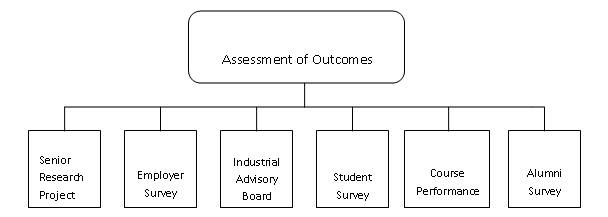Performance of students on the Rising Junior Examination prompted the former Provost/Vice- President of Academic Affairs to initiate a review of the General Education program. In 2006, a faculty task force was convened to review the General Education program. The task force was given the following assignments:
The Task Force reviewed Rising Junior Examination data and deliberated on the learning outcomes the Grambling State University General Education program should support. The Task Force worked for approximately ten months. At the completion of the work of the General Education Task Force, the General Education curriculum was revised. Four goals and twenty-two learning outcomes were identified and adopted.
General Education Program Goals
General Education Student Learning Outcomes
The learning outcomes are aligned with specific courses.
The new General Education requirement received Board approval during the spring 2008 semester. The program was implemented during the fall 2008 semester. To provide continuous oversight of the General Education Program, a General Education Committee was established at the beginning of the fall 2009 semester. During this same time, in an effort to provide oversight to the General Education program, it was administratively housed in the College of Arts & Sciences. The associate dean of this college works closely with the General Education Committee to make sure this program is evaluated and evaluation results are used to make program improvements. The chair of the General Education Committee reports directly to the associate dean of the College of Arts & Sciences. This Committee met twice during the fall 2009 semester. The Committee discussed strategies that should be implemented to assess the General Education program.
Because Grambling State University’s General Education program must be aligned with the eleven general education learning outcomes identified by the Louisiana Board of Regents, during the fall 2009 semester the Associate Dean of the College of Arts & Sciences completed a curriculum map that highlights the alignment. The map also aligns the University’s General Education courses with specific learning outcomes, which is beneficial to course planning and identifying the potential for embedded assessment assignments.
In an effort to ensure each of the twenty-two learning outcomes is evaluated, a 5-year assessment cycle plan was adopted by the General Education Committee. This plan identifies how each learning outcome will be assessed as well as the individuals responsible for collecting and reviewing assessment data. Direct and indirect assessments are identified for use. Program faculty will use assessment results to determine if students are meeting learning outcomes that have been identified for specific courses. This information will be shared with the General Education Committee. This Committee will ensure assessment data are used to make program improvement. At the end of the 5-year cycle, recommendations will be made regarding the effectiveness of the General Education Program and how it supports the mission of the institution.
The assessment cycle begins this academic year (2009-10) with the assessment of five learning outcomes. These outcomes are listed below. Content faculty in English, mathematics, chemistry, biological sciences, and First Year Experience will work with the General Education Committee to evaluate these outcomes. The performance of students on embedded assignments in a specific class is currently being reviewed as well as overall course performance. Prior to the beginning of the fall 2010 semester, the assessment will be complete and the results used 1) to make changes to the courses aligned with these five learning outcomes and 2) to implement improved assessment tools in an effort to enhance student achievement.
Degree Program Outcomes and Assessment
Content area faculty have identified student learning outcomes for each degree program offered at Grambling State University. Each program has a faculty member who serves as a program coordinator. This coordinator takes the lead in making sure program faculty assess student learning outcomes. Faculty evaluate the extent to which learning outcomes are being met and use results to make program improvement.
Those programs that are accredited by national accrediting agencies complete a program review that is aligned with the accreditation cycle, which ranges from every 4 to 6 years. Grambling State University has forty-four programs that are accredited. Those programs that are not accredited, many of which do not have accrediting bodies, review specific learning outcomes annually as a part of the planning and assessment process at the University. At the beginning of each fall semester, learning outcomes that will be evaluated during that academic year are identified, along with the assessment methods. At the end of the academic year, the assessment data that were collected are reviewed and reflected upon, and, where appropriate, courses and curriculum improvements are implemented.
This section of the narrative focuses on the assessment of student learning outcomes for three degree programs, two with national accreditation recognition (Drafting Design Technology, Nursing) and one without mandatory accreditation (Art).
Example: Drafting Design Technology (B.S. degree)
The Drafting Design Technology (DET) program faculty have identified student learning outcomes. Graduates of the Drafting Design Technology Program will demonstrate
The Drafting Design Technology program has an assessment plan that regularly evaluates student learning outcomes. The assessment tools used include direct and indirect measures. These include student surveys, alumni surveys, employer surveys, Industrial Advisory Board feedback, course performance, and a capstone senior research project.

The data collected are analyzed on an annual basis and used by the program coordinator and faculty to make program improvements.
| Drafting Design Technology Program Outcome Assessment | ||
| Assessment Tools | Assessment Administered | Data Evaluated |
| Student Survey | Once a Year | End of Spring Semester |
| Alumni Survey | Once a Year and Continuously Through the Year | End of Spring Semester |
| Employer Survey | Once a Year | End of Spring Semester |
| Industrial Advisory Board | Every Spring Semester | End of Spring Semester |
| Senior Research Projects | Every Semester | Every Semester |
| Course Performance | Every Semester | Every Semester |
| Senior Exit Survey | Every Semester | Every Semester |
Additional Information: